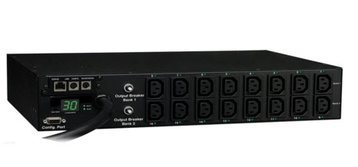Rack-mounted power distribution units come in a wide range of styles and capabilities, ranging from devices that are little more than high capacity power strips to fully intelligent, remotely manageable PDUs that give the data center NOC detailed information about power usage, along with control over power distribution at a software level.
Rack PDUs are available in several mounts, ranging from those that take 1U or multiple Us of space in a rack, to those that are known as “0 RU” and get mounted along the edges of racks, to those that get stuck in unused spaces at the top or bottom corners of a rackmount enclosure. Each of the physical designs is available in various versions, from fully intelligent manageable power devices to simple extensions of electric outlets suitable for the rack space in which they are installed. Selecting what type of rack PDU is appropriate for your data center is fairly straightforward; an exercise in matching your data center needs to the capability delivered by the PDU you wish to use.
There are four fundamental types of rack PDU:
1. Basic PDU
The basic PDU provides reliable power distribution without any special features or functionality. They are available in various densities and in different mounting types.
2. Metered PDU
With a metered PDU there is sufficient information provided by the PDU itself to properly configure the device without worry about overloading the equipment.
3. Intelligent PDU
Intelligent PDUs offer the features of metered PDUs with the addition of remote monitoring and control capabilities.
4. Switched PDU
Switched PDUs add the ability to remotely control the state of each outlet on the PDU, allowing administrators to remotely power cycle equipment.
Additional capabilities of intelligent PDUs may include metering at the input and output level and real-time monitoring of power consumption and environmental factors such as draw, temperature, humidity, and crest power. Interaction with DCIM software or general system management tools can allow intelligent PDUs to become an integral part of maintaining peak operating effectiveness in the data center.
There are also additional PDU features that are often used to define a specific type of PDU. These include Automatic Transfer Switch (ATS) PDUs, dual-circuit PDUs, and hot-swappable PDUs.
ATS and dual-circuit capable PDUs serve similar roles depending upon the equipment that they are used to support. If the desire is to provide two power sources to increase system reliability, the ATS PDU can be used if the equipment itself is not capable of maintaining that dual connection to power. In this environment the ATS PDU provides an automated transfer from primary to secondary power in the case of power outage (or whatever pre-defined conditions trigger the switch, from a complete outage to unusual loads).
A dual-circuit PDU works when the hardware being powered is able to accept redundant power and does its switching internally. In this environment the equipment is simply plugged into both power delivery circuits while the PDU is appropriately cabled to individual, discrete power sources. In many ways the ATS PDU adds the N+1 capability of the dual-circuit PDU to equipment not supporting or configured to handle multiple power sources on its own.
Hot-swappable PDUs are self-explanatory. They allow the PDU to be swapped out to replace a dying unit or to install an updated version. There are both manual and automatic hot-swappable PDUs available on the market which differ primarily in the type of user interaction necessary to handle the switching between live and backup PDU systems. Hot-swappable units allow maintenance tasks to be performed without taking down the powered systems.
There are no hard and fast rules which define a specific set of capabilities in a PDU. Some vendors break PDUs into only two categories; basic and intelligent. For these vendors, any capability beyond that found in an extension cord falls into the intelligent category. For this reason the selection of PDUs between multiple vendors requires careful attention to detail.
PDU management tools can be found that work both in and out of band, some connecting via Ethernet, others serially, and most recently, USB. Almost all of the technologies allow the PDU connections to be cascaded, limiting the amount of cabling necessary to provide communications and monitoring from installed PDUs within the data center.
Determining the appropriate form factor for your PDUs is also part of the selection process. While a standard rackmount PDU may hay have a 1U or 2U form factor, a 0U PDU that mounts vertically along the side of your rack needs to actually fit in the space you have available. There are also PDUs available that fit in the ‘dead’ space at the top and bottom of certain standard rack enclosures; using this type of PDU will require having the appropriate rack in place.
Make sure that you also consider the PDU selection as a whole, and not on an individual unit basis. A mix of PDU types may be appropriate if they can all be monitored and managed via the same software console. Paying extra for a PDU with a display is pointless if the mounting position means that the display can’t be read.
Matching the type of PDU deployed to a rack to the equipment running in that rack, or the role that rack is playing in the data center, can allow money to be most effectively spent by providing appropriate capabilities, rather than effectively over-provisioning PDUs for racks that need little more than a basic device.
And while different vendor PDUs may all offer monitoring via SNMP or similar standard protocols, be very careful when considering implementing a PDU infrastructure that uses more than one vendor’s product. All PDUs are not created equal and as you move up the value chain, the combination of features and capabilities can vary widely between vendors, even at similar price points.
If you are interested in learning more watch our free webinar on hyperconvergence.


